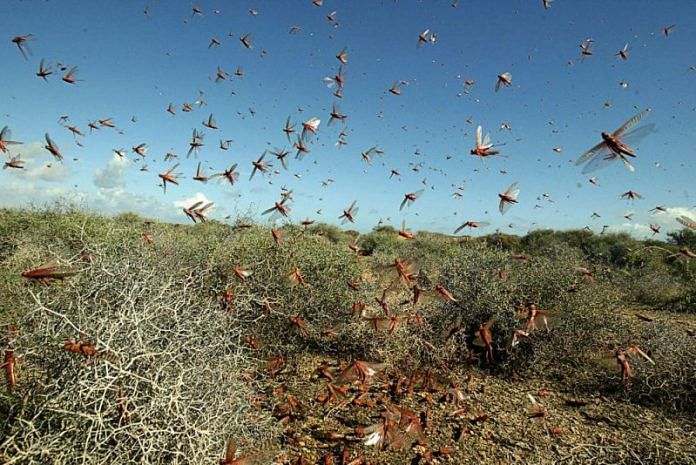New Delhi: From a distance, they look like an army laying seige to large swathes of farmland. Bright yellow in colour, these are locusts, moving relentlessly from Iran to Pakistan and devouring crops in their path. Having recently invaded Sindh — Pakistan’s second largest cotton-producing belt — millions of these insects are now inching closer to India’s Rajasthan.
On 19 June, sensing impending danger, Indian and Pakistani officials met to figure out solutions to tackle this incoming menace. The Locust Warning Organisation (LWO), headquartered in Jodhpur, has also issued a warning to all areas along the India-Pakistan border to keep an eye out for incoming swarms. In Rajasthan, the last major attack was reported in 1993.
There have already been some reports about locust attacks in parts of Jaisalmer district.
Potential disaster for Pakistan
Pakistan’s Ministry of National Food Security and Research had said the locusts first emerged in January this year from Sudan and Eritrea on Africa’s Red Sea Coast, hit Saudi Arabia and Iran in February, and entered south-western Pakistan in March.
According to the United Nations Food and Agriculture Organisation (FAO), these insects first hatched in Saudi Arabia and parts of north and east Africa before proceeding towards the India-Pakistan border.
Farmers, especially cotton growers, in Pakistan have been facing sleepless nights over the approaching pests. The country’s textile industry depends on cotton production, and thousands of people are engaged in it. With an already weak economy, Pakistan cannot afford to lose its cotton, and especially when it has just received a bailout package from the International Monetary Fund.
But statistics predict that the country’s textile industry is set to fall 18 per cent this year due to low cotton production.
Irregular rainfall and longer and hotter summers caused by climate change have already affected crop yields, making locust infestation potentially devastating.
Also read: US drug authority warns Indian homoeopathy firm after it finds insects & rodents at factory
What are locusts?
Locusts are classified as a species of short-horned grasshoppers. They are usually solitary, but under specific conditions, these insects form migratory swarms. Locusts eat almost all crops and non-crop items such as leaves, flowers, bark, stem and seeds. An adult locust can eat food equivalent to its weight ever day.
Rainfall after periods of drought and vegetation trigger abundant breeding, making locusts gregarious and nomadic in search of food.
The insects swarming the Indo-Pak border areas are desert locusts, known for their ability to fly long distances. They are able to travel up to 150 km per day with favourable wind conditions.
Preventive measures
The LWO has set up a helpline for farmers in Rajasthan, and 800 hectares have already been treated with insecticides near Jaisalmer, said its deputy director K.L. Gurjar.
In Pakistan’s Balochistan, another region infested with these pests, 5,020 hectares have been treated with insecticides, according to Mohammed Tariq Khan, technical director at the department of plant protection in Pakistan’s Ministry of National Food Security and Research. Farmers in over 25 towns in Balochistan, however, said the government has failed to prevent the swarms and resulting crop destruction, the Dawn reported.
Bureaucratic inefficiencies and unstable security situation in some areas have further slowed down the Pakistani government’s capacity to respond to the situation there.
Saving Great Indian Bustard or controlling locusts?
Arindam Tomar, Chief Wildlife Warden of Rajasthan, has urged the government to find a pesticide that will not harm the critically-endangered Great Indian Bustard, which feeds on locusts.
With just over 100 left, the Bustard is listed in Schedule I of the Indian Wildlife (Protection) Act, 1972. Tomar has called for an end to the use of chemical pesticides to ward off locusts, which could also potentially harm the Bustards.
“We are trying to find a pesticide that will kill locusts but not harm any other species. Controlling these insects is important but so is saving the endangered Great Indian Bustard,” he said.
Climate change to blame?
Locusts are usually seen around June and July, as the monsoon arrives. However, unusually ‘good ecological conditions’ — caused by heavy rains and cyclones — have led to intensive breeding of locusts this year.
The swarms originated in Saudi Arabia’s Rub’ al Khali desert, also known as the Empty Quarter, where locusts were able to breed after massive inland flooding caused by Cyclone Mekunu last year.
The Empty Quarter is the largest contiguous sand desert in the world, and has not seen such flooding in over 20 years.
According to a 2017 report by Climate Analytics, the risks of flooding as a result of cyclones has increased in recent years due to higher levels of precipitation and rising sea levels induced by climate change.
Also read: Male or female, mating is equally risky for these insects, finds IISc study



